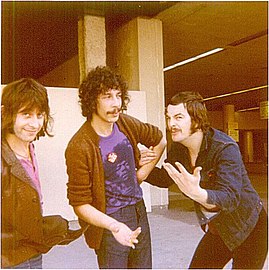Ashton, Gardner & Dyke
| Ashton, Gardner & Dyke | |
|---|---|
 |
|
| General information | |
| Genre (s) | Jazz rock , blues rock |
| founding | 1968 |
| resolution | 1972 |
| Last occupation | |
| Tony Ashton | |
| Kim Gardner | |
| Roy Dyke | |
Ashton, Gardner & Dyke were a British rock band that Tony Ashton and Roy Dyke formed with Kim Gardner in London in 1968 after the collapse of The Remo Four , with which they had previously played .
history
After the Remo Four broke up , Ashton and Dyke continued to play together. The bassist Kim Gardner and initially the guitarist Steve Howe joined them. They went on tour accompanying PP Arnold and Delaney & Bonnie ; Howe left the band early and switched to Yes .
Due to disagreements between the band and their manager Vince Melouney , who was guitarist for the Bee Gees , the debut album Ashton Gardner and Dyke could not appear until 1969. The single Resurrection Shuffle sold well and reached number 3 on the British charts in 1971. Until then, the band attracted attention with live performances, where they were completed by Dave Caswell ( trumpet , flugelhorn , banjo ), Lyle Jenkins ( saxophone , flute ) and Mick Lieber (guitar) and a hard rock influenced by blues and jazz played.
On the second album The Worst of Ashton, Gardner & Dyke , which was released in 1971, the trio was supported by Chris Barber , Eric Clapton , George Harrison and Stan Webb . The album presents a rough blues rock.
In 1972 the last record What a Bloody Long Day It's Been came out on the market, which was recorded together with the winds Dave Caswell, Lyle Jenkins and John Mumford as well as the guitarist Mick Liber. But sales fell short of expectations. Ashton, Gardner & Dyke previously recorded the soundtrack The Last Rebel with Jon Lord (supported by Dave Caswell, Lyle Jenkins, Mick Liber and Steve Howe).
The band broke up in mid-1973; Gardner and Dyke ran a short-term reunion of the Remo Four and then played for Badger . Ashton first went to Medicine Head and was part of the Family briefly before forming a duo with Jon Lord.
Tony Ashton died of cancer on May 28, 2001 in London . A few months later, on October 24, 2001, bassist Kim Gardner also died of cancer. Roy Dyke is involved in various projects in his adopted home of Hamburg.
Discography
Studio albums
| year | title |
Top ranking, total weeks, awardChart placementsChart placements (Year, title, rankings, weeks, awards, notes) |
Remarks | ||||
|---|---|---|---|---|---|---|---|
|
|
|
|
|
|
|||
| 1971 | Resurrection shuffle | - | - | - | - |
US178 (6 weeks) US |
First published: 1971
|
gray hatching : no chart data available for this year
more publishments
- 1969: Ashton, Gardner and Dyke
- 1971: The Last Rebel
- 1971: The Worst of Ashton, Gardner and Dyke
- 1972: What A Bloody Long Day It's Been
- 2002: Let It Roll - Live 1971
- 2011: Live In Montreux 1970
Singles
| year | Title album |
Top ranking, total weeks, awardChart placementsChart placements (Year, title, album , rankings, weeks, awards, notes) |
Remarks | ||||
|---|---|---|---|---|---|---|---|
|
|
|
|
|
|
|||
| 1970 | The Resurrection Shuffle Resurrection Shuffle |
DE22 (6 weeks) DE |
- | - |
UK3 (14 weeks) UK |
US40 (10 weeks) US |
First published: December 1970
|
| 1971 | Can You Get It single track |
DE44 (1 week) DE |
- | - | - | - |
First published: July 1971
|
More singles
- 1969: Maiden Voyage / See the Sun in My Eyes
- 1969: Rolling Home / New York Mining Disaster 1941
- 1970: Hymn to Everyone
- 1971: delirium
Web links
- Band portrait (rock circus)
- Ashton, Gardner & Dyke at Allmusic (English)
- Ashton, Gardner & Dyke at Discogs (English)
Individual evidence
- ↑ Chart information
- ↑ Band portrait (Alex Gitlin)
- ↑ a b Chart sources: DE UK US